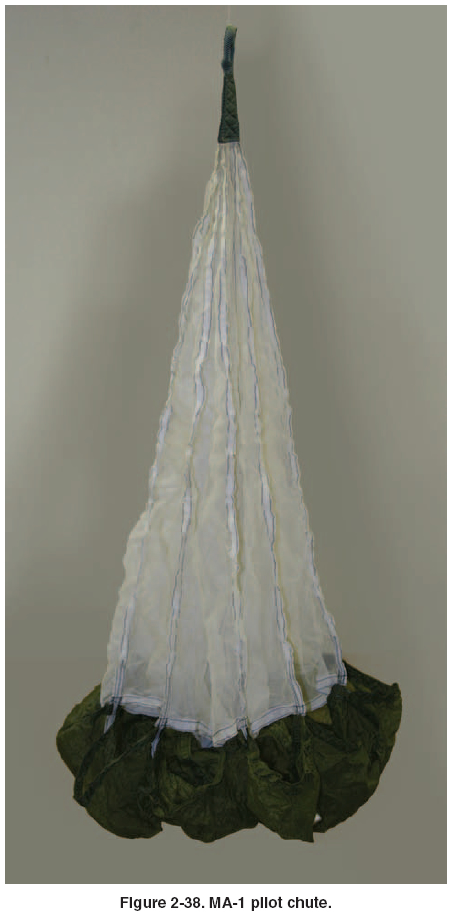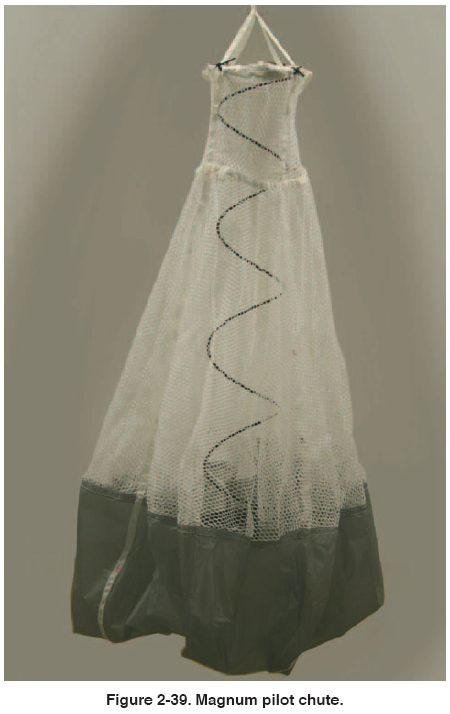Chapter 2
PILOT CHUTES
A pilot chute is a small parachute, which is used to
deploy the main or reserve parachute. In the earliest uses
of parachutes, the parachute was static line deployed.
With the advent of manually operated or “free fall” parachutes,
the need for a pilot chute was quickly recognized.
There are two basic types of pilot chutes. The first is the
spring-loaded design. This uses a collapsible spring,
which is compressed in the parachute container and held
closed with the ripcord. When the ripcord is pulled, the
pack opens and the pilot chute launches into the
airstream. The pilot chute provides drag and pulls the
canopy from the pack as the parachutist or load falls
away. During this process, the pilot chute also provides
tension on the lines of the deploying canopy and helps the
opening sequence. Spring-loaded pilot chutes are used
primarily for emergency and reserve parachutes. In addition,
they are used in military free fall and training systems
for the main parachute.
The second type of pilot chute is the “hand deploy”
design. This type consists of the pilot chute canopy but
does not have a spring to launch it. Instead, the parachutist
extracts the folded pilot chute from a pouch or the
container and launches it into the airstream. The pack is
held closed by a locking pin attached to the bridle of the
pilot chute. As the pilot chute inflates, it extracts the pin
from the locking loop and pulls the parachute from the
pack. The rest of the opening process is similar to the
spring-loaded pilot chute. This configuration came into
popularity in the mid 1970s and is now the primary
method of deployment in skydiving.
SPRING-LOADED PILOT CHUTES
Spring-loaded pilot chutes date from the 1920s. However,
it wasn’t until 1940 that the spiral vane pilot chute was
invented. This design used a spiral spring that is easy to
collapse and pack. The most common type of spiral vane
pilot chute used today is the MA-1 model. [Figure 2-38]
This is used in several military parachute assemblies. In
the early days of skydiving, military pilot chutes such as
the MA-1 and others were popular. Soon commercial
designs were introduced that improved on the MA-1 with
better launch and drag characteristics. These included the
Grabber® and Hot Dog® pilot chutes. Both of these were
primarily for use with main parachutes.
With the advent of the hand deploy pilot chute for the
main, most of the improvement in spring-loaded pilot
chute design has focused on its use in the reserve or emergency
parachutes. This has paralleled the improvements in container design and the increased use of AADs. Both
of these require better pilot chutes than in the past.

One example for reserve use is the Magnum® pilot chute
designed by National Parachute Industries. [Figure 2-39]
With its unique shape, it provides maximum drag at low
speeds such as are experienced during cutaways. Its
design has been licensed by other manufacturers for use
in their assemblies. Additional designs include the Vector
II reserve pilot chute and the Stealth pilot chute. The
Vector II design is a “ballute” configuration that eliminates
the use of mesh. In the event of an unstable launch
on its side, the mass of fabric is sufficient to lift the pilot
chute and deploy the parachute. The Stealth pilot chute
uses a conventional mesh design but has a unique
spring/cap configuration that allows the pilot chute to virtually
disappear when packed, hence the name.

| 
